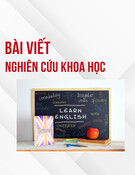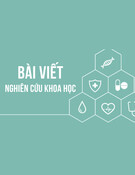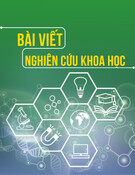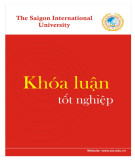
TNU Journal of Science and Technology
230(03): 38 - 44
http://jst.tnu.edu.vn 38 Email: jst@tnu.edu.vn
EFFECTIVENESS OF THE EXTENSIVE READING METHOD IN
ENHANCING READING SKILLS AMONG THE FIRST-YEAR STUDENTS IN
ENGLISH EDUCATION AT A UNIVERSITY IN VIETNAM
Nguyen Thi Minh Loan*, Duong Thi Le Hang, Bui Thi Thu Hang
TNU - School of Foreign Languages
ARTICLE INFO
ABSTRACT
Received:
21/10/2024
This article explores the impact of the Extensive Reading method on
the reading skills of first-year English majors at a Vietnamese
university. Conducted over 13 weeks, the study assessed changes in
the reading comprehension of students before and after the
intervention. Participants engaged in self-directed reading with
materials of varying difficulty levels, encouraging independent
learning outside of class. After completing their readings, the students
wrote reviews or summaries, allowing the researchers to track their
progress in critical thinking and reading comprehension. Additionally,
a post-study survey gathered insights into the experiences and attitudes
of students toward the Extensive Reading method. Results revealed
significant improvement in reading comprehension, as demonstrated
by increased test scores following the intervention. Participants
expressed a positive view of the Extensive Reading approach,
highlighting its role in improving reading skills and fostering a greater
interest in reading for pleasure and personal learning. Overall, the
Extensive Reading method proved effective in enhancing the reading
abilities of the students and promoting autonomous learning.
Revised:
10/02/2025
Published:
11/02/2025
KEYWORDS
Action Research
Attitudes
Extensive Reading
Method
Reading Comprehension
HIỆU QUẢ CỦA PHƯƠNG PHÁP ĐỌC MỞ RỘNG TRONG VIỆC CẢI THIỆN
KĨ NĂNG ĐỌC CHO SINH VIÊN NĂM THỨ NHẤT NGÀNH SƯ PHẠM TIẾNG
ANH CỦA TRƯỜNG NGOẠI NGỮ - ĐẠI HỌC THÁI NGUYÊN
Nguyễn Thị Minh Loan*, Dương Thị Lệ Hằng, Bùi Thị Thu Hằng
Trường Ngoại ngữ - ĐH Thái Nguyên
THÔNG TIN BÀI BÁO
TÓM TẮT
Ngày nhận bài:
21/10/2024
Nghiên cứu này khám phá tác động của phương pháp Đọc Mở Rộng
đối với kỹ năng đọc của sinh viên chuyên ngành tiếng Anh năm thứ
nhất tại một trường đại học ở Việt Nam. Nghiên cứu kéo dài 13 tuần,
đánh giá sự thay đổi trong khả năng đọc hiểu của sinh viên trước và
sau can thiệp. Sinh viên tham gia tự đọc các tài liệu có độ khó khác
nhau, khuyến khích học tập độc lập ngoài lớp. Sau khi đọc, họ viết bài
đánh giá hoặc tóm tắt, giúp các nhà nghiên cứu theo dõi tiến bộ về tư
duy phản biện và đọc hiểu. Ngoài ra, một khảo sát sau nghiên cứu đã
thu thập ý kiến của sinh viên về phương pháp Đọc Mở Rộng. Kết quả
cho thấy sự cải thiện rõ rệt về đọc hiểu, thể hiện qua điểm số tăng.
Sinh viên đánh giá cao phương pháp Đọc Mở Rộng vì đã giúp cải thiện
kỹ năng đọc và khơi dậy hứng thú đọc sách để giải trí và học tập.
Ngày hoàn thiện:
10/02/2025
Ngày đăng:
11/02/2025
TỪ KHÓA
Nghiên cứu hành động
Thái độ
Đọc mở rộng
Phương pháp
Khả năng đọc hiểu
DOI: https://doi.org/10.34238/tnu-jst.11369
* Corresponding author. Email: loannguyen.sfl@tnu.edu.vn

























